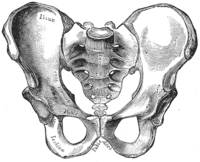
Photo from wikipedia
Background: Previous studies have observed that individuals with patellofemoral pain (PFP) have decreased hip abduction torque, as well as increased hip adduction and knee abduction during activities with uniltateral weight… Click to show full abstract
Background: Previous studies have observed that individuals with patellofemoral pain (PFP) have decreased hip abduction torque, as well as increased hip adduction and knee abduction during activities with uniltateral weight bearing1,2. Considering that, a significant number of patients with patellofemoral osteoarthritis (PFOA) have a previous history of PFP3, it is speculated that the mechanical causes of PFP and PFOA may be similar. However, although alterations in hip muscle strength and lower limb kinematics during various functional activities have been reported in patients with PFP, they have not been explored in subjects with PFOA. Objectives: The objectives of this study were to compare the hip eccentric abductors torque and the trunk, pelvis, hip, and knee frontal plane kinematics in subjects with and without PFOA isolated during the single-leg squat. Methods: This is a cross-sectional study. The volunteers were divided into two groups: control group (CG - healthy individuals) and PFOA group (PFOAG - individuals with PFOA grade II or III). Eccentric peak torque of the hip abductors was evaluated using an isokinetic dynamometer Biodex Multi-Joint System 3, at angular speed of 30°/s. Trunk, pelvis, hip and knee kinematics were recorded during the single-leg squat using a 6-camera, 3-dimensional motion-analysis system (Vicon Motion Systems, Nexus System 2.1.1 and 3D Motion Monitor). The t-test Student was used to compare the variables between the groups. The significance level was set at 5% for all analyses (p ≤ 0.05). Results: The CG was composed by 12 participants (41.7% women). PFOA had 9 participants (44.4% women). Age (p = 0.1), height (p = 0.9) and body mass (p = 0.2) showed homogeneity between groups. Regardind body mass index, the OAPFG showed higher values (p = 0.02). PFOAG showed greater increased hip adduction than CG (p = 0.05) (Table 1). However, there were no differences among groups for trunk lean, contralateral pelvic elevation and knee abduction (p > 0.05). PFOAG showed lower hip abductor torque compared with the CG (p = 0.006). Conclusion: PFOA individuals showed greater hip adduction and lower hip abductors torque than the CG. Thus, it is suggested that muscle weakness may excessively influence hip adduction. Hip adduction is the main component of the knee valgus in the frontal plane. So, excessive dynamic valgus results in an increase Q-angle and, consequently, an increase in the lateral forces acting on the patella, causing greater stress on the lateral patellofemoral joint, which may contribute to disease progression. Therefore, we suggest that the hip abductor strengthening should be considered when treating individuals with PFOA. References: [1]Nakagawa TH, Moriya ETU, Maciel CD, Serrao FV. Trunk, Pelvis, Hip, and Knee Kinematics, Hip Strength, and Gluteal Muscle Activation During a Single-Leg Squat in Males and Females With and Without Patellofemoral Pain Syndrome. J Orthop Sport Phys Ther. 2012;42(6):491-501. [2]Nakagawa TH, Moriya ETU, Maciel CD, Serrao FV. Frontal Plane Biomechanics in Males and Females with and without Patellofemoral Pain. Med Sci Sport Exerc. 2012;44(9):1747-1755. [3]Utting MR, Davies G, Newman JH. Is anterior knee pain a predisposing factor to patellofemoral osteoarthritis? Knee. 2005;12(5):362-365. Acknowledgments: Sao Paulo Research Foundation (FAPESP) (Grant/Award Numbers: 2017/20057-8; 2017/25959-0; 2018/10329-3). Disclosure of Interests: None declared
Journal Title: Annals of the Rheumatic Diseases
Year Published: 2020
Link to full text (if available)
Share on Social Media: Sign Up to like & get
recommendations!